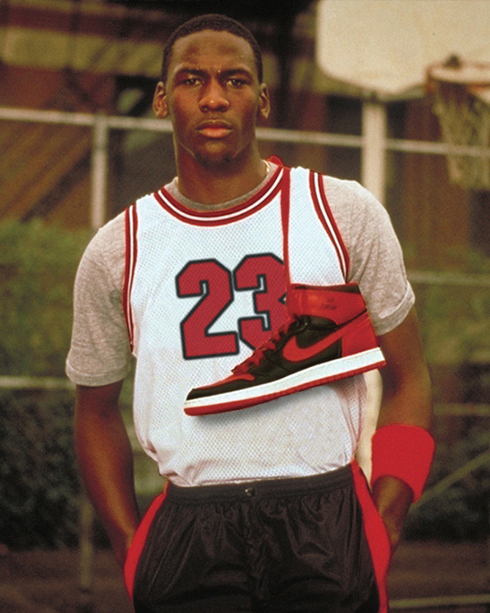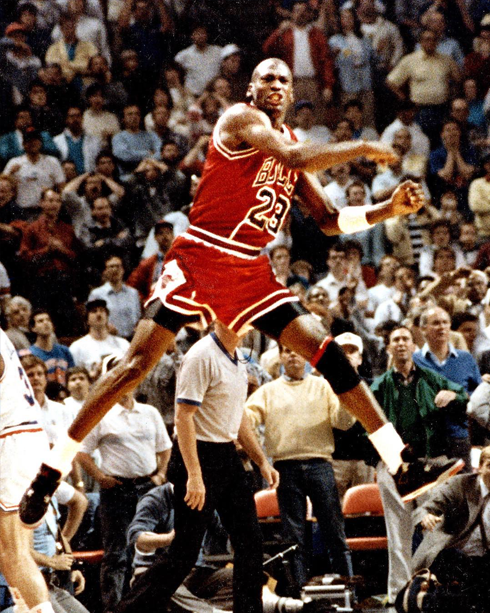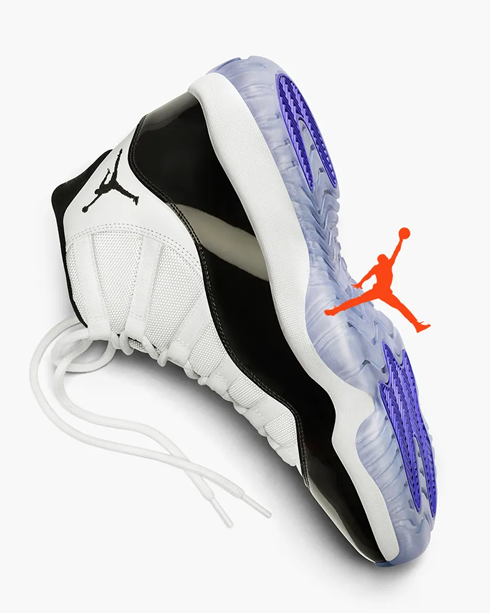Jordan
3
The sneaker that saved a brand.

A fragile partnership
Today, Michael Jordan’s partnership with Nike is as strong as a rock, but back in the 1980s it was still in its early phases and potentially only temporary. Having signed to Nike in 1984 after being offered a deal so good he could not refuse, Jordan appeared happy with his first two signature shoes. The first had been a breakout success, while the second had offered something even more sophisticated and stylish by taking a more fashion-forward angle. However, by 1987, Jordan’s contract was nearing its end and his mind was wandering to other possibilities outside of his work with Nike. All that changed as a legendary designer entered the fray, creating a striking new basketball trainer that galvanized the partnership and altered the course of sneaker history. That shoe was the Air Jordan 3.
Troubling times
When Michael Jordan joined the Chicago Bulls off the back of a strong college career in 1984, the expectations for his future in the NBA were high. In his first three seasons, people came to realize that he would surpass these expectations to become one of, if not the, greatest of all time. This made him highly sought-after when it came to endorsements, and, while Nike had him on their books from the start, the continuation of his initial contract was far from guaranteed. This fact came into sharp focus when, in 1987, the man responsible for designing the first two Air Jordans, Peter Moore, left the company along with Nike’s Marketing VP, Rob Strasser, who had been the one to sign Jordan to the brand in the first place. Without Moore’s creative talent and Strasser’s business acumen, Nike would have real trouble enticing Jordan back to make another shoe, let alone the whole signature line that exists today. What made the situation even more challenging was the fact that the pair, who had formed a strong partnership during their decade together at Nike, had broken away to set up their own company, Sports Inc. The duo wielded serious power after their previous exploits working on the Air Jordan team and began working on a plan to woo Michael Jordan over to their side. Fortunately for Nike, before Moore left, he had charged a young designer by the name of Tinker Hatfield with the creation of the Air Jordan 3 – a seemingly small decision that became incredibly important in the history of the Jordan signature line.
A promising designer
Today, Tinker Hatfield is one of the most revered shoe designers in the world, but back in 1987, he was still relatively unknown outside of Nike. He had originally trained as an architect and, having worked in that capacity for Nike since 1981, he had only begun designing shoes in 1985. Two years later, he was already showing signs that he could become one of the best in the business, having designed the Air Trainer 1 – made for explosive tennis star John McEnroe – and the revolutionary Air Max 1. In creating the former, he had shown great perception to realize that there was a gap in the market for an all-round sports shoe, while the latter was informed by his architectural background. However, making a basketball shoe for the greatest player in the world was a completely different proposition, and it was unclear whether or not he could pull it off. As well as his keen intuition and unique background, he would demonstrate another important skill in developing the Air Jordan 3 that would set him apart from his competitors – the ability to listen.
An untapped resource
By the time Tinker was handed creative control of the project, it was already six months behind schedule, and all he had was a series of sketches and ideas left by Moore. His team was up against it when competing with the newly founded Sports Inc. and other footwear giants like adidas, who had been Jordan’s first choice before he had signed to Nike and were slowly entering the conversation once more. Tinker realized that they had an untapped resource in Michael himself – after all, when designing anything, whether it be a building or a shoe, it’s important to know who’s going to use it and what for, letting their preferences and requirements guide the design process. He immediately flew out to meet MJ, who he had never met before, to get an understanding of how he thought, how he played and what he wanted in a shoe, both in terms of style and functionality. Here, his unconventional background served Tinker once again. While studying at the University of Oregon, he had been an amateur track athlete under Bill Bowerman. The running coach and Nike co-founder was known for thinking outside the box when it came to shoe design and also worked closely with athletes to find out what they needed in performance footwear. Tinker took both of these things on board. He found that Michael had very clear ideas about what he wanted and was actually keen to have his input heard. In fact, one of Tinker’s masterstrokes when working on the Jordan 3 was to involve the shoe’s primary user closely in the design process, paying close attention to his comments to make sure that the shoe would meet his expectations. As he flew home, the young designer had everything he needed to construct the next great Jordan sneaker.
Fulfilling demands
Meeting Michael Jordan in person had clearly inspired Tinker, and he threw himself into his work alongside his team, which included other Nike stalwarts early in their careers such as Ron Dumas, the group putting in long shifts and barely sleeping in order to get the prototype ready in time for the deadline. He wrote the Air Jordan Manifesto, in which he summed up his impressions of the man he had met for the very first time that day, saying things like “Michael Jordan demonstrates to me that youthful exuberance, fun and desire need not be a clownish unsophisticated and loudmouth affectation”, and describing him as “educated and animated” with “class and style”. His aim was to fulfill all of the basketball player’s wishes and imbue the design with Jordan’s sense of fun and hunger to win while also making it fashionable and sophisticated. One of his most demanding requests was to have a shoe that did not need breaking in and was comfortable straight out of the box, thus allowing him to wear a brand new pair each game. He also wanted it to be lighter and with a lower cut around the collar, which would improve his ability to move freely around the court and achieve the incredible “air” that he was becoming known for. Tinker had also noted Michael’s fondness for high-end fashion and his tendency to wear luxurious suits and Italian leather shoes at events and parties. With these things in mind, he swapped out the stiff leather used on other basketball shoes of the time for floater leather, which has a naturally grained finish, making it lighter, softer and pleasant to the touch. It is still highly durable, and the tanning process is such that the leather can be dyed with a range of different colors. He also shaped the leather around the collar into a lower, mid-top height, making it more flexible but still protecting the ankles – a first for a basketball shoe at the time that Nike later summed up with the following phrase: “Three-quarter height is designed for players who want unrestricted ankle flexion as they move up and down the court.” These simple changes gave Michael a basketball trainer that he could wear fresh out of the box each game, which was both lightweight and durable with an elegant, finely crafted aesthetic.
Standout features
With these important features ticked off, Tinker moved on to other design aspects, which can be seen in one of his sketches from 26th July, 1987. Labelled “AJ. Revelation White Shoe” and with smaller writing stating “My favorite so far”, it marked out the 100% white full grain floater alongside comfort-giving features like the perforations over the top of the foot and the “good quality duraplush” collar. Alongside these, two of the Jordan 3’s most standout elements appear in the drawing – the elephant-print overlays in the forefoot and heel, and the Jumpman logo. The first is referred to as “Cement or Jade Grey Elephant Hide”, and the second “Little Man Jordan Patch”. Both unassuming names, while the former would go on to define the AJ3 and reappear on many other Nike and Jordan sneakers, the latter became the bold symbol of the Jordan Brand, and remains one of the most recognisable brand logos to this day.
The Jumpman logo
The prototype of the Air Jordan 3 prepared by Hatfield and his team was everything that Michael Jordan had asked for and more. Its mid-cut collar provided him with flexibility to move easily around the court while also protecting his ankles, the tumbled leather was soft and supple when the shoes were brand new, allowing him to wear a fresh pair for each game, and the exotic elephant-print panels on the toe and heel gave it a luxurious look similar to the fine Italian shoes he loved to wear, making the shoe fashionable as well as functional. Tinker had also brought over his innovative Nike Air window in the heel from the Air Max 1, becoming the first Jordan basketball trainer to reveal the bouncy cushioning technology within the midsole. He had also added an exaggerated heel panel which hosted the Nike Air logo and was the only place on the outer with a Nike swoosh, the AJ3 following in the footsteps of the AJ2 with its lack of any sidewall branding. Most importantly, though, the visionary designer had done something no one else had thought to do: put Jordan himself at the very heart of the sneaker with the Jumpman logo prominently displayed in the center of the tongue. Interestingly, this was not his first instinct, as his early sketches show the sneaker with swooshes on its flanks like the Air Jordan 1 – a feature playfully reproduced on the Air Jordan 3 Tinker Hatfield in 2018. Fortunately, he had found the image, first captured during a photoshoot for Life magazine ahead of the 1984 Olympics and later recreated by Nike, amongst Peter Moore’s sketches, sparking an idea. The dynamic silhouette of Jordan leaping through the air with his arm outstretched towards the hoop encapsulated everything about the player and his incredible movement and flight. The logo had never been meant for use on the shoe itself, merely as marketing material, but in another moment of genius, Tinker realized that giving the Jumpman pride of place on the tongue would bring the Jordan signature line a stronger individual identity while also impressing Michael and distinguishing his sneakers from Nike’s other models.
A historic pitch
Despite designing a shoe that ostensibly seemed perfect for Michael, as Tinker arrived at the pitch meeting, something was wrong – Jordan was absent. Sat with Nike co-founder Phil Knight and the player’s family, he waited nervously for four hours until Michael finally walked through the door. He had been off playing golf with none other than Peter Moore and Rob Strasser, who had made their own pitch for why he should join them at Sports Inc. Having already faced one convincing proposal that day and still considering the possibility of going with adidas, it was not the best time for Jordan to hear about yet another sneaker. It was a make or break moment for Tinker, and, in many ways, the odds were stacked against him. That makes what happened next even more remarkable. He sat down with Michael, reminding him of their earlier conversation and his requests, before going on to explain how he had fulfilled each one. As Michael began to come around, the prototype was revealed. His smile widened as he realized that Tinker had really listened. The fine materials, the lower collar, the elephant-print graphic – everything was there, and seeing his own silhouette on the tongue just capped things off perfectly. In that moment, it was clear that Tinker had hit the spot, and Michael agreed to go with Nike once more. Years later, Phil Knight still credits Tinker Hatfield with saving his brand that day.
A special All-Star Weekend
Having secured Jordan’s allegiance once more, the challenge now ahead of Nike was to successfully launch its latest model. As with the previous two iterations, Michael played a big role by wearing the shoe while doing what he did best – impressing on the basketball court. He was seen in the Air Jordan 3 as early as November 1987, but it was his performance at the NBA All-Star Weekend in early February of 1988 that really thrust the new design into the limelight. In one of the most well-known Slam Dunk competitions in basketball history, MJ wore the Jordan 3 White Cement colorway while competing against some of the best in the business at the time. In the final, he met rival Dominique Wilkins, who had beaten Jordan when the two first encountered each other back in 1985. Injuries to both players had prevented them from going head to head in ‘86 and ‘87, so this was their first battle since Jordan had experienced defeat against him, making him even more eager to win. And if he needed more of an incentive, the fact that the competition was being held at Chicago Stadium was it, as thousands of adoring fans cheered him on. At the time, the two men were the league’s top scorers and the final was a tightly fought contest. Going into the final throw, Jordan needed a near perfect score of 49 points to secure the victory. He strode all the way to the opposite end of the court to start his runup before turning and powering back across its entire length, building up tremendous speed in the process. He took off from the free-throw line and launched himself through the air, slamming the ball into the net with just his right hand and achieving the highest possible score of 50 points to win the Slam Dunk competition for the second year in a row. Not only did his on court prowess delight the crowd, it also showed off the Air Jordan 3, wowing sneaker fans with a stylish new basketball trainer that clearly had plenty of bounce. Just one day later, he turned up to the All-Star Game in a different colorway – the Black Cement. Although this was to be the only time he wore this particular design on the court, he made it a memorable one, scoring 40 points in front of more than 18,000 supporters in an MVP-winning performance that further boosted the profile of the shoe.
OG colorways
The White Cement and Black Cement colorways came out around the same time as this magnificent weekend, both becoming instant hits thanks to Jordan’s exploits. He continued his great form into the rest of that season, wearing the White Cement for the majority, before switching to another of the four original colorways, the Fire Red, for the 1988 playoffs. The fourth design, known as True Blue, he wore just once in 1988, at an exhibition game between the NBA All-Stars and Team USA, and wouldn’t be seen in them again until 2001, by which time he was playing out the final years of his career with the Washington Wizards.
An impressive season
Throughout the ‘87-’88 season, MJ performed to an incredibly high level, having one of the best years of his career in terms of stats, even though the Bulls failed to win the title once again. He was joined by key teammates, including Scottie Pippen and Horace Grant, who would later be linchpins of the championship-winning team in 1991 and beyond, while Phil Jackon became a member of the coaching staff, working as an assistant ahead of his magnificent run as head coach in the 90s. All of this helped Jordan to win his first NBA MVP award and his only Defensive Player of the Year accolade in 1988. He also finished as Scoring Champion for the second year running and was even Steals Leader for the first time. Each of these achievements came while wearing the Air Jordan 3, thus solidifying its place in sneaker history.
Michael Jordan and Mars Blackmon
But it wasn’t just Michael’s on-court antics that helped to grow the shoe’s popularity, it was also his off-court persona. More specifically, it was his unforgettable adverts with Spike Lee’s fictional character Mars Blackmon from the 1986 hit movie, She’s Gotta Have It. In the black-and-white film, Mars is a quirky sneaker fan and Jordan enthusiast, making him a relatable individual when appearing alongside the idealized figure of Michael Jordan. The pair showed up in print ads, including a two-page spread which depicted Michael in the Black Cement and Mars in the White Cement, with the text “The Best on Earth” below the former and “The Best on Mars” written underneath the latter. Perhaps more memorable, though, were their TV adverts, which led to catchphrases like “It’s gotta be the shoes!”, famously stated by Mars as he tried to figure out what made Michael so good. One commercial starts with a close-up of Mars next to a basketball hoop as he claims to be the best. His reason for this statement: “Air Jordan, Air Jordan, Air Jordan”, which Mars repeats as the camera pans down to show him standing on Michael’s shoulders in the Air Jordan 3 White Cement. MJ walks off and Mars hangs on to the hoop, shouting “Money, Money, why you wanna do that to me?”, which made Money one of Jordan’s many nicknames. The comical pair appeared together in a whole series of adverts that boosted the shoe’s popularity, forming a winning partnership that saw them play around with several subsequent Jordan sneakers.
Michael Jordan and Tinker Hatfield
Another powerful partnership to emerge from the Air Jordan 3 was that of Hatfield and Jordan. The talented designer changed the rulebook on shoe collaborations with athletes by taking note of the desires and needs of the players to create footwear that would truly serve them. His decision to put Jordan so prominently on the shoe itself endeared him to the man, acting as a symbolic gesture of his importance to both Hatfield and Nike that made him into a true collaborator on his own signature line. Jordan has since praised the team who worked on the AJ3 for building a timeless product and even referred to Tinker as his “right-hand man” on anything design-related, as the two have become quite close over the years. They went on to craft many more Jordan sneakers together, with Tinker also designing dozens of shoes for Nike over more than three decades with the company, where he ended up as Vice President for Design and Special Projects.
Honoring a legend
Even with all of the new Jordan sneakers that have come out over the years, the Air Jordan 3 has remained popular and is still as collectible today as it was when it was first released. The four original colorways, which were a revelation in 1988, are particular favorites, the White Cement and Black Cement both being re-released multiple times after the first retro versions were launched in 1994. Fans of the Fire Red and True Blue had to wait a little longer, the latter coming in 2001 and the former not until 2007. These retro sneakers have been credited as being some of the first to influence the boom of the retro market and part of the reason why basketball sneakers became cultural icons rather than just functional items, something which may have been affected by the early 2000s talent of Kobe Bryant. The NBA superstar chose to honor his great mentor, Michael Jordan, by wearing the True Blue retro during the 2003 All-Star Game – Jordan’s 14th and final time at the exhibition event before permanently retiring. Star of the LA Lakers, who had just come off the back of their very own three-peat, Kobe was incredibly popular at the time, leading the votes in the fan ballots to be the first name on the Western Conference team sheet. In an amazing battle, Jordan put the Eastern Conference team two points up with 4.8 seconds remaining in overtime, before Kobe hit back by making two of his three free-throw shots to take the game to an unprecedented double overtime. The Western team went on to win and, after the game, Jordan’s remarkable career was celebrated with a performance by Mariah Carey and a movie of his best sporting moments. Kobe often received personalized pairs of sneakers from his mentor, including a Lakers-inspired version of the Air Jordan 3, and his appearance in the True Blue both honored Jordan and brought the silhouette to the attention of a whole new generation of sneaker fans. This saw its popularity continue to grow through other celebrities, such as American rapper DJ Khaled, who got his own unique version in 2017, award-winning Colombian singer J Balvin, who worked on two AJ3 colorways in 2023 and 2024, and Justin Timberlake, the global star performing in a personalized pair during the 2018 Super Bowl halftime show. As well as this, there have been unique and eye-catching collaborations with Fragment Design, A Ma Maniére and many other fashion brands – a testament to the Jordan 3’s timeless quality.
A lasting legacy
In designing the Jordan 3, Hatfield did something incredible. He managed to combine Jordan’s desired performance attributes with the style he demanded as a follower of fashion into a single sneaker. Its distinctive design and stylish, high-quality materials evolved the Jordan signature line, making it look like no other basketball trainer around at the time and setting a new standard for the industry both in terms of aesthetics and technology. Its list of firsts not only made it a popular silhouette, it also brought Michael back into the fold and transformed a nascent partnership into something that would serve as the basis for one of the most monumental shoe brands in history. For its part in this remarkable story, the Air Jordan 3 will forever be remembered as the shoe that saved Nike, and its illustrious designer, the man who made it happen.


